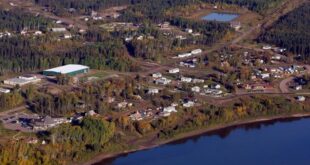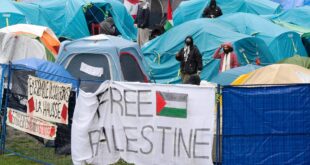Carryover fires are igniting after smouldering for months underground

A helicopter hovering high above the ground canvasses a portion of snow-covered terrain near Fox Lake, east of High Level, Alta.
On the ground, about 20 provincial firefighters, fully dressed in bunker gear, scout the area to map out wildfire hotspots and dig up ground fires.
"Our firefighters are always monitoring fires in the winter, so we're taking flights and checking out some of our carryover fires," said Victoria Ostendorf, a wildfire information officer for the High Level Forest area.
"But it's not as common to see as many carryover fires as we have this winter."
Alberta Wildfire has been responding to an increased number of winter wildfires in the area due to drought-like weather conditions this season. About 16 fires have carried over from the 2023 season in the High Level area alone.
Carryover wildfires refer to fires that begin in previous seasons and smoulder underground for months before reigniting in the spring once the snow melts.
While carryover fires are common, and the organization has carried out winter wildfire operations before, Ostendorf said it hasn't ever reached this scale.
"A lot of this area is smouldering," she said.
The High Level forest area experienced around 175 wildfires last year, burning around 800,000 hectares of land. Many of the fires affected communities like Fox Lake, home to 2,543 people, according to the provincial government's regional dashboard.
Once crews map out the area where hotspots pop up, Ostendorf said they work out a plan to identify the ones of concern and use tools to expose the earth and dig up that heat.
Alberta Wildfire's main priority is to work in areas close to communities to mitigate fire risk for residents, but also work on remote areas where trees have a bigger tendency to catch fire or burn hotter.
"This area is adjacent to the community, [so] it's really important for us to take care of this area by exposing the heat in the ground, or lessening the hazards to the community, as well as the smoke impacts," she said.
The province's 2023 wildfire season, which burned a record 2.2 million hectares across Alberta, ended with drought-like conditions. Alberta Wildfire is hiring more firefighters and expects to be fully staffed by April 15, earlier than usual.
According to provincial information officer Melissa Story, 57 wildfires were burning across Alberta as of Tuesday. There have been 12 new wildfires since the start of 2024, as well as more than 60 that carried over from last year.
"Our five-year average is around six, so we're sitting at about 10 times as many as we usually see," Story said.

A look at how Alberta Wildfire responds to increased winter wildfires
8 hours ago
Alberta Wildfire has been responding to an increased number of winter wildfires due to warmer and drier weather this season. CBC’s Trevor Wilson flew with crews near Fox Lake, east of High Level, to see winter wildfire fighting in action.
Once the snow melts and exposes dead, dry grass on the landscape, Story said wildfires could start easily and travel quickly. Alberta Wildfire is hoping to leverage some of its successes from last year, including extended firefighting in the spring and fall months.
"The wildfire season legislatively starts on March 1; however, we do have the opportunity … to start things earlier should we need to," she said.
Ostendorf said this summer is expected to be warmer and drier, but it's too early to tell how the 2024 fire season will shape up. Officials still need to see how much rain will fall in the area this spring.
It's one of the reasons why winter operations, along with tree trimming, are important, she said.
"Fire can dig deep into the ground, especially in this area … but it can travel as well and reemerge as a wildfire," Ostendorf said.
"So this work is to get ahead of that and prevent that from happening."
ABOUT THE AUTHOR
Reporter
Aaron is a reporter with CBC Edmonton. Originally from Fredericton, N.B., he was editor-in-chief of his campus newspaper, The Aquinian. He enjoys creative writing, poetry, photography and music. He can be reached at aaron.sousa@cbc.ca.
*****
Credit belongs to : www.cbc.ca
 MaharlikaNews | Canada Leading Online Filipino Newspaper Portal The No. 1 most engaged information website for Filipino – Canadian in Canada. MaharlikaNews.com received almost a quarter a million visitors in 2020.
MaharlikaNews | Canada Leading Online Filipino Newspaper Portal The No. 1 most engaged information website for Filipino – Canadian in Canada. MaharlikaNews.com received almost a quarter a million visitors in 2020.







